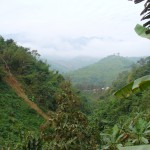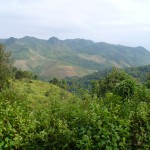You’ve got to be crazy to drive from Luang Prabang to Phonasavanh and the Plain of Jars.

For 260 kilometers, or about 160 miles, you drive a two lane road through incessantly twisting terrain of limestone hills that slope precipitously into crevasses that seem to dip deep into the nether world. To advance 5 miles in the right direction, you often have to follow the road 10 miles out of your way in order to gain the pass at a mountaintop or get around a crevasse as the elevation varies from 1500 to 2000 meters along the way. No wonder you only average about 30 miles per hour.
This is the kind of landscape we saw from the Mekong River at a comfortable distance. To drive the six or seven hours through it is another experience altogether. In daylight, it’s not really threatening since the road is wide enough to avoid serious misfortune, but it’s tortuous to driver and passenger both since the sharp turns and obstacles come relentlessly. You pitch sideways over and over again, and then up and down as you plow through some rutted or damaged section. Along the steepest hills, massive dirt and rock landslides have been cleared from the rainy season after the dirt threatened to take back the roadways dug through it. At one point in our trip, we were delayed for a half hour while two backhoes tossed dirt and rock off a break they were creating upslope of the road to avoid future problems.
Especially in the periodic small villages, you’re also threatened with chickens criss-crossing the road and children meandering aimlessly along the dirt walks and the road itself. The free-range village dogs find some reasons to move across your path or sample something in the middle of the street. Cattle assemble at will in front of you and one blithely occupied the center stripe of the road like a police checkpoint. And that’s not counting all the other vehicles trying to negotiate the serpentine rises and falls at various speeds.

Happily, all of the living or still-living creatures including the youngest have mastered roadside survival skills, since most vehicles ignore any kind of speed limit through the villages, substituting a horn honk or two for any kind of slowdown.
The village buildings along the roads – clumps of thatched bamboo shacks and grassy roofs – seem just as precarious in this environment. Most of them set on ridgelines or narrow flattened sections of the hills. The front appears stable at the road level, but the backs are often poised delicately on stilts and hanging over the cliff edge.
Why do this? The vistas are spectacular.

Laos is the only landlocked country in SE Asia. However, in the morning, oceans of fog wash up on these hills, covering the lower ones and straining to submerge the largest ones. The moisture paints the distant landscape in misty blue peaks. As a result, it’s wildly fertile country. When the fog recedes, you see that this is a world of many greens – dark rainforest, bright banana plants, browned teak, and the light greens of planted vegetables – all growing on seemingly vertical terrain. You know there are rivers and streams down there, but you rarely see them in the profusion of green.
And this is the way from the north to visit the Plain of Jars, the vast flatland in the mountains filled with large ancient funerary urns and the memories of bombings during the Vietnam war.


Hope you packed your Dramamine! 😛